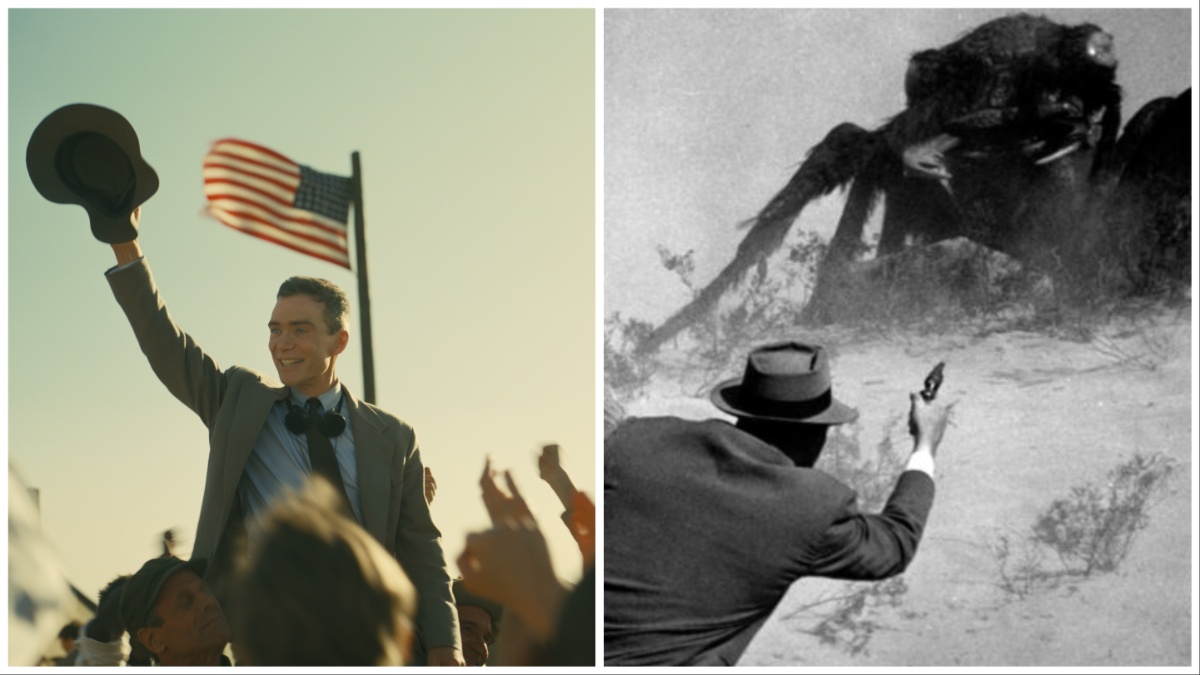
When we recently compiled our list of science fiction movies based on true stories, one film that didn’t make the list was Christopher Nolan‘s Oppenheimer. After all, the technology behind the nuclear bomb can no longer be said to be undiscovered, sadly. Nonetheless, Oppenheimer remains the archetypal science fiction story—one about a mad scientist who devises a new machine that changes the world through terrible unforeseen consequences. He is an an American Prometheus, yes, but also a regular Yankee Frankenstein. More than that though, by ushering in the nuclear age, Oppenheimer may have lit the fuse on the genre of cinematic science fiction.
It is hardly a new observation, but walk into any cinema in the 1950s and you will find no shortage of creatures, monsters, or occasionally people grown to giant size by the mysterious power of radiation. You don’t need to look too closely to figure out what very real fears lie behind the flying saucers laying waste to American monuments.
But even so, looking back from our vantage point in 2024 it can be hard to appreciate how much the shadow of the mushroom cloud completely transformed science fiction movies, and the genre as we knew it, forever.
Sci-Fi Before the Atom
To fully understand how the nuclear bomb changed science fiction cinema, we need to go back and look at sci-fi as it existed in the pre-nuclear age. There is no denying it existed. A Trip to the Moon was showing us spaceflight as far back as 1902. Metropolis appeared in 1927, and every futuristic city from Blade Runner to The Fifth Element has been riffing off its style ever since.
But if you step back from inspecting individual classics to look at the genre as a whole and the concerns it focuses on, then the perspective can seem to narrow. For instance, you cannot be expected to call yourself a real cinephile in this day and age unless you stop once every couple of weeks to moan that the industry is flooded with remakes and sequels at the expense of original ideas.
But between 1908 and 1941 we have seen no fewer than 15 adaptations of The Strange Case of Dr. Jekyll and Mr. Hyde by Robert Louis Stevenson. Frankenstein, surprisingly, doesn’t even approach those numbers, but the Mary Shelley tale still boasts three silent movie versions before James Whale’s iconic 1931 version, starring Boris Karloff, made everyone forget any other version has ever existed. That version spawned seven more sequels, including the obligatory Abbott and Costello crossover (shared cinematic universes aren’t new either).
But outside of direct adaptations, you have films like Homunculus (1916), The Monster (1925), and the Karloff-led The Man They Could Not Hang (1939), which are Frankenstein in all but name. There was also The Mysterious Island (1929) and The Island of Lost Souls (1932), adaptations of Jules Verne’s “The Mysterious Island” and H.G. Wells’ The Island of Doctor Moreau, respectively. Both feature creatures warped and distorted by science run amok.
Then, of course, there is the Frankenstein adjacent subgenre: What If Organ Transplants but Evil? This now mostly forgotten subgenre featured films such as The Hands of Orlac (1924) and Mad Love (1935), both based on the novel by Maurice Renard, alongside brain transplant movies like the Karloff and Bela Lugosi starring Black Friday (1940) and the “transplanting for shits and giggles” movie, Dr. X (1932).
This era also saw Captive Wild Woman (1943), a film about an ape transformed into a woman thanks to a gland transplant (it would’ve been the whole brain, but the idea that a human soul could be transplanted into an animal violated religious doctrine), and The Monster and the Girl (1941) about an ape with a gangster’s brain transplanted into it who then goes on to kidnap a girl (gangsters don’t have souls I guess?).
When scientists weren’t conducting surgery well outside of the realms of the Hippocratic Oath, they were inventing rays. There was 1920’s The Invisible Ray—which is not to be confused with the 1936 version starring Boris Karloff (the man liked to work)—The Crazy Ray (1924), The Death Ray (1925), and the ray that restores a man’s life for six hours in Six Hours to Live (1932). The most common plotline, however, was that the scientist is using his invention to do crimes and the square-jawed hero has to stop him. The idea of technology, and even social change, might have an effect on how people live on a wider scale is rarely touched upon, with exceptions such as Metropolis, The Master of the World (1934), and Things to Come (1936).
So what was the reason for the narrow focus?
You could make an argument that this is simply a matter of technology finally catching up with our vision. After all, the post-World War II period brings us not just nuclear anxiety, but financial prosperity, color film becoming commonplace, and better special effects.
But cinema has always been about spectacle. There is a reason why one of the first movie stars is the famed illusionist Harry Houdini. People went to the cinema to see things they had never seen before, and cinema gave it to them whether you’re talking about the spaceship crashing into the Moon’s eye in A Trip to the Moon in 1902 or King Kong battling biplanes from the top of the Empire State Building in 1933.
The Nuclear Influence
After 1950, the game changes. Instead of four or five notable science fiction movies in a year, there are 15 to 20. Medical malfeasance and gadget heist science fiction give way to alien invasions, giant monsters, voyages into space and through time.
There is no arguing that a lot of these films are processing a single new piece of information—that rather than a crackpot inventor trying to steal some jewels, the threat is now that a government might, at a few minutes’ notice, decide to level entire cities.
The creature features like Them! (1954), It Came from Beneath the Sea (1955), Tarantula (1955), and The Giant Claw (1957) are straight out of the “subtext is for cowards” school of storytelling (while Godzilla adds to the genre in the way only a country on the receiving end of a nuclear bomb could). Alien invasion movies like Earth vs. the Flying Saucers (1956) and George Pal’s adaptation of The War of the Worlds (1953) give us a handily inhuman stand-in for Soviet Russia.
These tensions are also written loud and clear in Pal’s other H.G. Wells adaptation, The Time Machine (1960) where a rush for the nuclear bunkers provides an origin story for the Victorian novel’s Morlocks. But The Time Machine also shows science fiction cinema engaging with an idea that it had rarely touched upon until now: technology was going to change lives. And not always for the better.
It wasn’t a new idea—science fiction in print had been playing with this theme since the 19th century, but now cinema has begun to see the emergence of futures that might be different from today. The Time Machine was joined by April 1, 2000 (1952), a political satire about an Austria frustrated by its oversight by other powers in the aftermath of two world wars, and an adaptation of George Orwell’s Nineteen Eighty-Four.
Space movies like Forbidden Planet (1956) and Conquest of Space (1955) don’t just show us an exploration of outer space; they give us a timeline of centuries of events revealing how we got there (we get to the moon in the last decade of the 21st century, for instance), and hint at future bureaucracies and fashions, and a life as distant from the 1950s as the 1950s were from the wild west. There is a paradox here that these films first begin to build off into their own genre amidst a flood of movies about the imminent destruction of the human race. It is only when humanity first contemplates its ability to make itself extinct that we start to see a widespread grappling with the idea of what the future would look like if it persists.
Sci-fi movies got serious, because the stakes of science reality had become so severe. How could they not after one man in a porkpie hat mused, “I am become Death, the destroyer of worlds?”
The post How the Real Oppenheimer Ushered in Modern Sci-Fi Cinema appeared first on Den of Geek.






